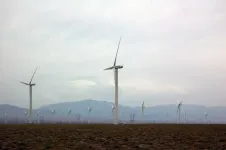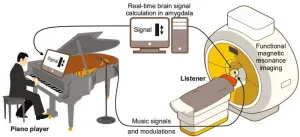(Press-News.org)
Black carbon is the most dangerous air pollutant you’ve never heard of. Its two main sources, diesel exhaust and wood smoke from wildfires and household heating, produce ultrafine air particles that are up to 25 times more of a health hazard per unit compared to other types of particulate matter. Despite its danger, black carbon is understudied due to a lack of monitoring equipment. Regulatory-standard sensors are wildly expensive to deploy and maintain, resulting in sparse coverage in regions infamous for poor air quality, such as the greater Salt Lake City metropolitan area in Utah.
A University of Utah-led study found that the AethLabs microAeth MA350, a portable, more affordable sensor, recorded black carbon concentrations as accurately as the Aerosol Magee Scientific AE33, the most widely used instrument for monitoring black carbon in real time. Researchers placed the portable technology next to an existing regulatory sensor at the Bountiful Utah Division of Air Quality site from Aug. 30, 2021-Aug. 8, 2022. The AethLabs technology recorded nearly identical quantities of black carbon at the daily, monthly and seasonal timescales. The authors also showed that the microAeth could distinguish between wildfire and traffic sources as well as the AE33 at longer timescales.
Because black carbon stays close to the source, equipment must be localized to yield accurate readings. The microAethsensor’s portability would allow monitoring at remote or inaccessible stationary sites, as well as for mobile use.
“Having a better idea of black carbon exposure across different areas is an environmental justice issue,” said Daniel Mendoza, research assistant professor of atmospheric sciences at the University of Utah and lead author of the study. “The Salt Lake Valley’s westside has some of the region’s worst air quality partly because it’s closest to pollution sources, but we lack the ability to measure black carbon concentrations accurately. Democratizing data with reliable and robust sensors is an important first step to safeguarding all communities from hazardous air pollution.”
The study was published on Feb. 1, 2024, in the journal Sensors.
In the dark
Black carbon pollutants are a type of fine particulate matter (PM2.5), a class of air particles small enough to be inhaled into the lungs and absorbed into the bloodstream. Black carbon is true soot, produced when hydrocarbons do not fully burn, and has been shown to migrate into the heart, brain, fetal tissue, and other biological systems.
“The combination of increasing wildfires driven by anthropogenic climate change and steady population growth along the Wasatch Front in coming decades will result in new pollution challenges that Utah will have to face,” said Erik Crosman, assistant professor of environmental sciences at West Texas A&M University and a co-author of the study.“The portable MA350 ‘micro’ aethalometer could be utilized in building a better spatial observational network of accurate but lower cost black carbon sensors across the region.”
Though research suggests exposure to black carbon is 10 to 25 times more hazardous to respiratory and cardiovascular health than other PM2.5, long-term health outcomes are largely unknown. An accurate observation network is the first step to establishing disease risk and creating effective public health policies. This study, funded by the Salt Lake City Corporation, aims to help regions with poor air quality establish a baseline of black carbon distribution.
“It’s crucial that we target our measurements to identify the largest and most relevant black carbon sources,” said Drew Hill, a study coauthor who leads data science and applied research work at AethLabs. “We’ve added a feature rooted in physical principles to provide real-time estimates of the amount of measured black carbon produced by fossil fuel burning versus wood burning to allow researchers and policy makers to triangulate such sources.”
Having established the portable sensor’s accuracy and regional relevance, the researchers are measuring black carbon levels around the Salt Lake Valley, including testing concentrations present inside school buildings.
“First, you need to get readings. In some neighborhoods you could look at air quality concentrations, then look at the cancer or other disease rate in that neighborhood,” said Mendoza, who is also an adjunct assistant professor in the Division of Pulmonary Medicine at University of Utah Health. “Getting measurements with a high degree of accuracy, now we can really think about health and policy avenues to really protect everyone's lung health.”
Jeffrey Blair of AethLabs also contributed to the study, titled, “A long-term comparison between the AethLabs MA350 and Aerosol Magee Scientific AE22 Black Carbon Monitors in the Greater Salt Lake City Metropolitan Area.” Sensors 2024, 24(3), 965; https://doi.org/10.3390/s24030965.
END
Irvine, Calif., Feb. 26, 2024 — The University of California, Irvine has received a five-year, $4 million grant from the California Institute for Regenerative Medicine to establish a shared resources lab in the Sue & Bill Gross Stem Cell Research Center. The facility will offer essential technologies and training for the development of novel in vitro stem cell-based modeling that will serve researchers across the campus and the state.
“Stem cells possess the potential to transform into particular cell types, offering promising avenues for rejuvenating and restoring tissues harmed by injury or affected ...
Among the vast expanse of Antarctica lies the Thwaites Glacier, the world’s widest glacier measuring about 80 miles on the western edge of the continent. Despite its size, the massive landform is losing about 50 billion tons of ice more than it is receiving in snowfall, which places it in a precarious position in respect to its stability.
Accelerating ice loss has been observed since the 1970s, but it is unclear when this significant melting initiated – until now. A new study published in the journal PNAS, led by researchers ...
Researchers have shown that inedible species of butterfly that mimic each others’ colour patterns have also evolved similar flight behaviours to warn predators and avoid being eaten.
It is well known that many inedible species of butterfly have evolved near identical colour patterns, which act as warning signals to predators so the butterflies avoid being eaten.
Researchers have now shown that these butterflies have not only evolved similar colour patterns, but that they have also evolved similar ...
Human coexistence depends on cooperation. Individuals have different motivations and reasons to collaborate, resulting in social dilemmas, such as the well-known prisoner's dilemma. Scientists from the Chatterjee group at the Institute of Science and Technology Austria (ISTA) now present a new mathematical principle that helps to understand the cooperation of individuals with different characteristics. The results, published in PNAS, can be applied to economics or behavioral studies.
A group of neighbors shares a driveway. Following a heavy snowstorm, the entire driveway is covered in snow, requiring clearance for daily activities. ...
BEAUFORT, N.C. –With fish stocks declining globally, more than 190 countries recently made a commitment to protect about a third of the world’s oceans within “Marine Protected Areas,” or MPAs by the year 2030. But these designated areas of the ocean where fishing is either regulated or outright banned can come at a huge cost to some coastal communities, according to a new analysis.
To help prepare for the expansion of MPAs, an international team of researchers from Duke University, Florida State ...
To become carbon neutral by 2060, as mandated by President Xi Jinping, China will have to build eight to 10 times more wind and solar power installations than existed in 2022. Reaching carbon neutrality will also require major construction of transmission lines.
China land use policies will also have to be more coordinated and focused on a nation-wide scale rather than be left to ad hoc decisions by local governments. That’s because 80% of solar power and 55% of wind power will have to be built within 100 miles of major population centers.
These are the conclusions of a new study from ...
There is no doubt that water is significant. Without it, life would never have begun, let alone continue today – not to mention its role in the environment itself, with oceans covering over 70% of Earth.
But despite its ubiquity, liquid water features some electronic intricacies that have long puzzled scientists in chemistry, physics, and technology. For example, the electron affinity, i.e. the energy stabilization undergone by a free electron when captured by water, has remained poorly characterized from an experimental ...
How does listening to live music affect the emotional center of our brain? A study carried out at the University of Zurich has found that live performances trigger a stronger emotional response than listening to music from a device. Concerts connect performers with their audience, which may also have to with evolutionary factors.
Music can have a strong effect on our emotions. Studies have shown that listening to recorded music stimulates emotional and imaginative processes in our brain. But what happens when we listen to music in a live setting, for example at a music festival, at the opera or a folk concert? ...
DETROIT – A team of researchers from Wayne State University and the Barbara Ann Karmanos Cancer Institute has received a five-year, $9.6 million grant from the National Cancer Institute of the National Institutes of Health for the study “Genetic Variation in Cancer Risk and Outcomes in African Americans.” This is a Program Project Grant that includes three large studies. The team will work to improve the identification and clinical management of hereditary and multiple primary cancers in African Americans, a population that is currently underrepresented in genetic research.
According to Ann Schwartz, Ph.D., principal investigator of the project, professor and ...
RIVERSIDE, Calif. -- Vapers are susceptible to infection by SARS-CoV-2, the virus that spreads COVID-19 and continues to infect people around the world, a University of California, Riverside, study has found.
The liquid used in electronic cigarettes, called e-liquid, typically contains nicotine, propylene glycol, vegetable glycerin, and flavor chemicals. The researchers found propylene glycol/vegetable glycerin alone or along with nicotine enhanced COVID-19 infection through different mechanisms.
Study results appear in the American Journal of Physiology.
The researchers ...









